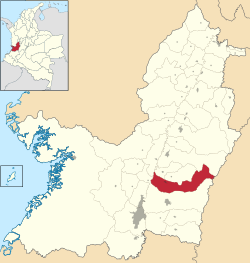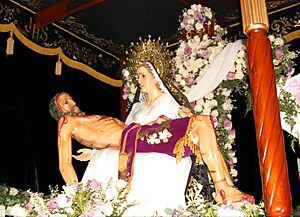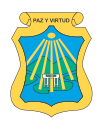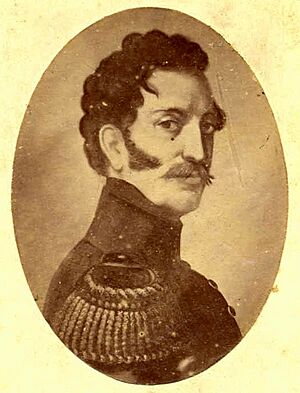El Cerrito, Valle del Cauca facts for kids
Quick facts for kids
El Cerrito
|
|||
|---|---|---|---|
|
Municipality and town
|
|||
|
|||
| Nickname(s):
Ciudad Cariño
|
|||
| Motto(s):
Paz y Virtud
|
|||

Location of the municipality and town of El Cerrito, Valle del Cauca in the Valle del Cauca Department of Colombia.
|
|||
| Country | |||
| Department | Valle del Cauca Department | ||
| Area | |||
| • Municipality and town | 441.9 km2 (170.6 sq mi) | ||
| • Urban | 3.52 km2 (1.36 sq mi) | ||
| Elevation | 967 m (3,173 ft) | ||
| Population
(2018 census)
|
|||
| • Municipality and town | 56,470 | ||
| • Density | 127.789/km2 (330.97/sq mi) | ||
| • Urban | 35,977 | ||
| • Urban density | 10,221/km2 (26,470/sq mi) | ||
| Time zone | UTC-5 (Colombia Standard Time) | ||
| Website | http://elcerrito-valle.gov.co/ | ||
El Cerrito is a town and municipality in the Valle del Cauca Department of Colombia. It is one of the 42 municipalities in this region.
The town is famous for the "El Paraíso" hacienda (a large estate). The writer Jorge Isaacs lived here and set his famous novel María in this very place. Part of El Cerrito's land is also within the Parque Nacional Natural Las Hermosas, a beautiful national park. El Cerrito is located about 47 kilometers (about 29 miles) east of Cali, which is the capital city of the department.
Contents
What's in a Name?
The name "El Cerrito" comes from the Spanish language. It means "The Small Hill" in English. This name refers to the hill where the town is built. This hill is part of the Andes Mountains in Colombia.
Exploring El Cerrito's Geography
El Cerrito is located on a flat area next to a river that shares its name. It sits on the western side of the Central Mountain Range.
The town is about 987 meters (3,238 feet) above sea level. Its average temperature is around 24 °C (75 °F).
The area has two main types of land. One part is mountainous, belonging to the western side of the Central Mountain Range. Its highest points include Paramo de las Hermosas (3,500 meters high), Cerro Pan de Azúcar, and El Alto de la Cruz. The other part is mostly flat or gently rolling. This area is part of the Cauca River valley.
The municipality has different climate zones, from warm to cold and even wilderness areas. Several rivers flow through El Cerrito, including the Amaime, Cauca, Cerrito, and Sabaletas rivers. There are also many smaller streams and a lagoon called Three Americas.
Neighbors of El Cerrito
El Cerrito shares its borders with several other towns. To the north, it borders Guacari and Ginebra. To the east, it borders Chaparral in the Tolima Department. To the south, it borders Palmira. And to the west, it borders Vijes.
Townships and Neighborhoods
El Cerrito includes several smaller towns and areas called townships. These are Santa Elena, El Placer, San Antonio, Santa Luisa, El Pomo, El Castillo, El Moral, El Carrizal, Aují, Los Andes, and Tenerife.
The main town area is divided into many neighborhoods. Some of these are San Rafael, Santa Bárbara, Chapinero, Buenos Aires, La Estrella, El Rosario, and Villa del Carmen.
Climate
| Climate data for El Cerrito (Tenerife), elevation 2,609 m (8,560 ft), (1981–2010) | |||||||||||||
|---|---|---|---|---|---|---|---|---|---|---|---|---|---|
| Month | Jan | Feb | Mar | Apr | May | Jun | Jul | Aug | Sep | Oct | Nov | Dec | Year |
| Mean daily maximum °C (°F) | 17.6 (63.7) |
17.8 (64.0) |
17.8 (64.0) |
17.7 (63.9) |
17.7 (63.9) |
17.8 (64.0) |
18.1 (64.6) |
18.3 (64.9) |
18.2 (64.8) |
17.7 (63.9) |
16.9 (62.4) |
16.8 (62.2) |
17.7 (63.9) |
| Daily mean °C (°F) | 13.4 (56.1) |
13.5 (56.3) |
13.7 (56.7) |
13.8 (56.8) |
13.9 (57.0) |
13.9 (57.0) |
13.8 (56.8) |
13.9 (57.0) |
13.7 (56.7) |
13.5 (56.3) |
13.3 (55.9) |
13.3 (55.9) |
13.6 (56.5) |
| Mean daily minimum °C (°F) | 9.7 (49.5) |
9.8 (49.6) |
10.0 (50.0) |
10.4 (50.7) |
10.5 (50.9) |
10.3 (50.5) |
10.1 (50.2) |
10.0 (50.0) |
10.0 (50.0) |
9.9 (49.8) |
9.9 (49.8) |
9.7 (49.5) |
10.0 (50.0) |
| Average precipitation mm (inches) | 95.6 (3.76) |
80.2 (3.16) |
123.3 (4.85) |
135.6 (5.34) |
108.6 (4.28) |
55.1 (2.17) |
41.0 (1.61) |
42.6 (1.68) |
72.1 (2.84) |
168.0 (6.61) |
158.1 (6.22) |
129.7 (5.11) |
1,209.8 (47.63) |
| Average precipitation days | 14 | 14 | 18 | 20 | 20 | 15 | 14 | 13 | 14 | 21 | 22 | 19 | 201 |
| Average relative humidity (%) | 85 | 84 | 84 | 85 | 85 | 83 | 80 | 78 | 81 | 84 | 87 | 86 | 84 |
| Mean monthly sunshine hours | 155.0 | 124.2 | 120.9 | 96.0 | 105.4 | 123.0 | 139.5 | 139.5 | 120.0 | 108.5 | 99.0 | 127.1 | 1,458.1 |
| Mean daily sunshine hours | 5.0 | 4.4 | 3.9 | 3.2 | 3.4 | 4.1 | 4.5 | 4.5 | 4.0 | 3.5 | 3.3 | 4.1 | 4.0 |
| Source: Instituto de Hidrologia Meteorologia y Estudios Ambientales | |||||||||||||
A Glimpse into El Cerrito's Past

The area where El Cerrito now stands was once home to the Native Pijaos people. They were led by a brave chief named cacique Calarcá. Later, in the 1500s, Spanish explorers led by Sebastián de Belalcázar arrived and took control of the territory.
An interesting story from that time is about Maria Luisa de la Espada. She was born nearby and inherited a large estate. Legends say her story attracts many tourists to the Tenerife district. They visit old houses and the ruins of her castle there.
In 1797, the village of El Cerrito first began to form. It was built on land donated by two ladies, Petrona and Sebastiana Cárdenas. The first Mass was held on August 30, 1825, by Father Manuel José Guzmán. The place was then named San Jerónimo.
Over time, the area grew. In 1854, it became a district called Guzmán, honoring Father Guzmán. Finally, on August 30, 1864, it was officially made a municipal district and given the name El Cerrito.
El Cerrito's Economy
The economy of El Cerrito is mainly based on farming and raising animals.
- Farmers grow crops like grapes, sugar cane, corn, soybeans, rice, and various tropical flowers, including beautiful orchids.
- Cattle breeding is also important, especially for processing leather.
- El Cerrito is known for making "Panderitos," which are tasty baked goods made from cassava flour.
- People also make furniture, especially from wood.
- Tourism is growing, with hotels and restaurants, especially in the countryside. The area's cliffs are popular for exciting activities like paragliding and mountain biking.
Fun Events in El Cerrito

El Cerrito hosts many exciting events throughout the year:
- Onion Festival: Held in the village of Tenerife every August.
- Peasant's Festivities: Takes place in the village of Auji in July, featuring a traditional children's reign.
- Holy Week: A traditional and important religious celebration.
- Anniversary Fairs: Celebrations marking the town's founding.
- Grape's Festival: Held in the village of Santa Elena.
- Blacks and Whites' Day: Celebrated in the village of El Placer.
- Kite Contests: Fun contests held during July and August.
- Our Lady of Chiquinquirá Celebrations: Religious festivities.
- Isaacsian Culture Festival: Organized by the Universitas Foundation Cultural Center.
Amazing Places to Visit
El Cerrito has many interesting places to see, especially old country estates called haciendas that have a lot of history.
- Historic Haciendas: Many old estates like El Albión, El Paraíso, Piedechinche, and La Concepción offer a glimpse into the past.
- Hacienda de El Paraíso: Located about 16 km from the town center. This is the famous place described in Jorge Isaacs' novel María. It's the most popular tourist spot and is part of the "Territorio Paraiso" tourist area. You can also enjoy extreme sports like paragliding, mountain biking, horse riding, and canoeing nearby.
- The Museum of Sugar Cane: This museum is part of the Hacienda Piedechinche. The hacienda house was built in the 1700s and shows typical old Colombian architecture. It has furniture and items from the 1800s and early 1900s. This area was important for the first sugar mills in the region.
- National Day of the Onion in Tenerife: This is one of the most famous festivals, celebrating agriculture. You can see very tall palm wax trees, some as high as 70 meters!
- The Farmer's Celebration in Ajui: A lively community celebration in the Auji district. It's part of the Our Lady of Carmen festivities and includes cultural events like the "Reinado infantil campesino" (children's peasant kingship).
- Other Attractions:
- Casa Cural (Parish House)
- "El Trincho" bridge
- Outdoors Theatre «Marina Arango»
- Hotel Club "El Paraíso"
- Ancient House of the Colegio "Jorge Isaacs"
- Universitas Cultural Center
- Railroad station and plazoleta (small square) Santa Bárbara
- Municipal Football stadium «Alfredo Vásquez Cobo»
- Park "Francisco Antonio Rada"
Territorio Paraíso Project
This is a government project aimed at improving tourism in El Cerrito and nearby towns like Guacara, Ginebra, and Palmira. It includes building better roads and offering support for tourism businesses.
Delicious Food of El Cerrito
When you visit El Cerrito, you can try many tasty dishes:
- Main Dishes: arroz atollado (a rice dish), sancocho (a hearty soup), pandebono (cheese bread), and empanada (savory pastries).
- Desserts: Don't forget to try the delicious sponge cake and blancmange (a sweet, creamy dessert).
- Fruits: The region has many fresh fruits like grapes, chontaduro (a type of palm fruit), mangoes, bananas, oranges, papayas, medlar, and caimos (Pouteria caimito).
Famous People from El Cerrito
Heroes of Independence
- José María Cabal: Born in El Cerrito in 1769, he became a general during Colombia's fight for independence. He fought bravely to defend cities and won important battles. He was a strong supporter of freedom.
- María Antonia Ruiz: Known as the "black heroine," she grew up on the San Agustín estate. During the independence movement, she promised to give her life for freedom. She bravely tricked enemy troops, making them think a large army was approaching, which helped save the day. Simón Bolívar himself visited her to thank her for her heroic act.
People from the 20th Century
- Henry Nieto Navia: (1945-2007) He was a lawyer and later became a priest. He was a founding member of the Universitas Cultural Center and worked to help people, especially in Tumaco.
- Álvaro Domínguez: A well-known footballer.
- Jefferson Lerma: Another famous footballer from El Cerrito.
Infrastructure and Getting Around
Roads
El Cerrito has a good road system that connects it to nearby towns like Buga, Rozo (Palmira), and Costa Rica (Ginebra). There are also local roads that connect to Ginebra.
Religion
Catholic Churches
El Cerrito has three Catholic parishes that belong to the diocese of Palmira:
- Our Lady of Chiquinquirá parish (the oldest, founded with the town).
- Perpetual Help parish (founded in 1990).
- Lord of Mercy Parish (founded in 2000).
Other Important Groups
El Cerrito is part of the Judicial District of Cali for legal matters. It also belongs to the Buga Circle of Registry and Notary and the electoral district of Valle del Cauca.
|
See also
 In Spanish: El Cerrito (Valle del Cauca) para niños
In Spanish: El Cerrito (Valle del Cauca) para niños






